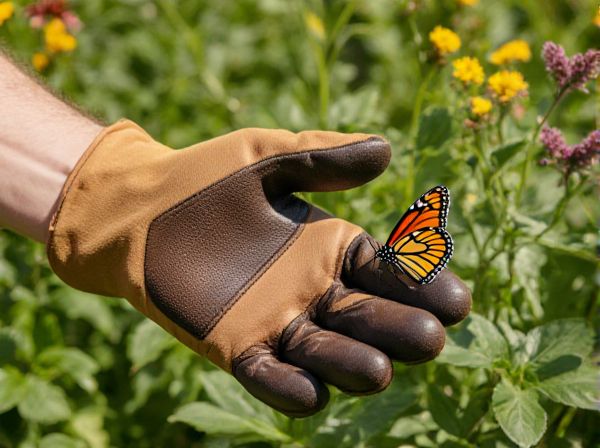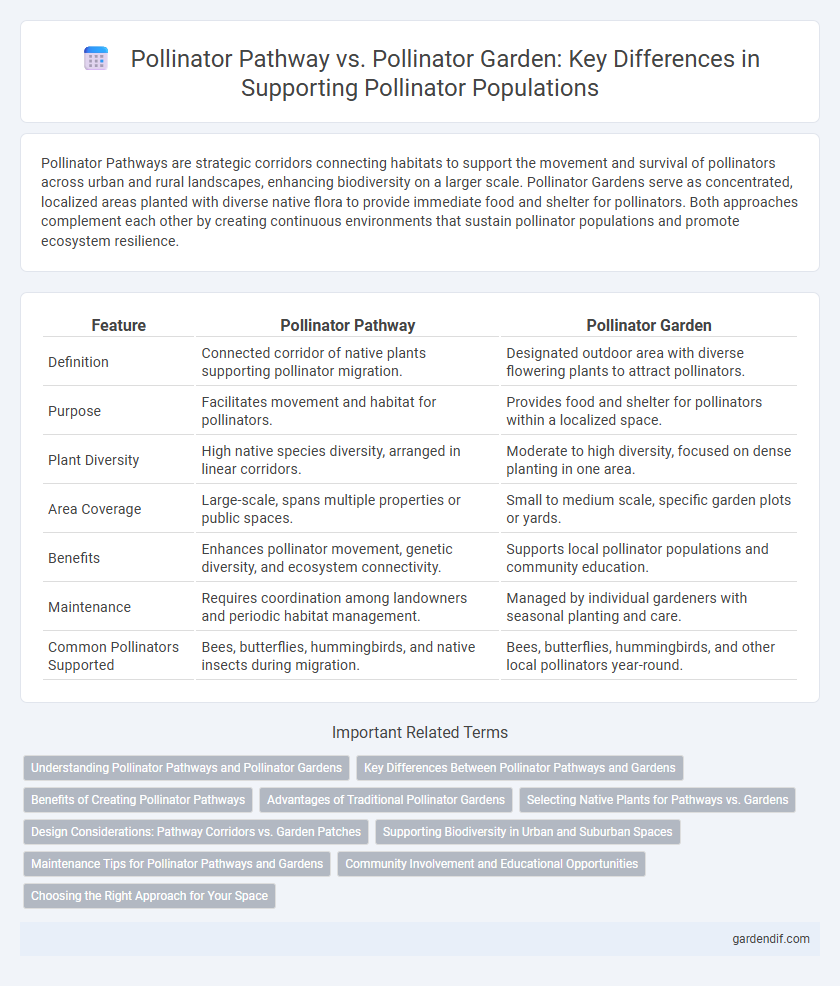
Pollinator Pathway vs Pollinator Garden Illustration
Pollinator Pathways are strategic corridors connecting habitats to support the movement and survival of pollinators across urban and rural landscapes, enhancing biodiversity on a larger scale. Pollinator Gardens serve as concentrated, localized areas planted with diverse native flora to provide immediate food and shelter for pollinators. Both approaches complement each other by creating continuous environments that sustain pollinator populations and promote ecosystem resilience.
Table of Comparison
| Feature | Pollinator Pathway | Pollinator Garden |
|---|---|---|
| Definition | Connected corridor of native plants supporting pollinator migration. | Designated outdoor area with diverse flowering plants to attract pollinators. |
| Purpose | Facilitates movement and habitat for pollinators. | Provides food and shelter for pollinators within a localized space. |
| Plant Diversity | High native species diversity, arranged in linear corridors. | Moderate to high diversity, focused on dense planting in one area. |
| Area Coverage | Large-scale, spans multiple properties or public spaces. | Small to medium scale, specific garden plots or yards. |
| Benefits | Enhances pollinator movement, genetic diversity, and ecosystem connectivity. | Supports local pollinator populations and community education. |
| Maintenance | Requires coordination among landowners and periodic habitat management. | Managed by individual gardeners with seasonal planting and care. |
| Common Pollinators Supported | Bees, butterflies, hummingbirds, and native insects during migration. | Bees, butterflies, hummingbirds, and other local pollinators year-round. |
Understanding Pollinator Pathways and Pollinator Gardens
Pollinator pathways create continuous corridors of native flowering plants that support the movement and foraging of pollinators such as bees, butterflies, and hummingbirds across urban and rural landscapes. Pollinator gardens, in contrast, are designated areas rich in diverse pollinator-friendly plants, providing critical nesting and food resources within localized spaces. Understanding these concepts helps enhance habitat connectivity and biodiversity by combining linear habitat networks with concentrated resource hubs for pollinator health and ecosystem resilience.
Key Differences Between Pollinator Pathways and Gardens
Pollinator Pathways are designed as interconnected corridors that support the movement and habitat needs of pollinators across larger landscapes, emphasizing connectivity and biodiversity. Pollinator Gardens are localized spaces focused on providing abundant floral resources and nesting sites within a confined area, primarily enhancing pollinator activity in urban or residential settings. Key differences lie in scale, purpose, and spatial design--pathways facilitate migration and genetic flow, whereas gardens concentrate on resource availability and pollinator health in specific locations.
Benefits of Creating Pollinator Pathways
Creating Pollinator Pathways enhances biodiversity by connecting fragmented habitats, enabling pollinators like bees, butterflies, and hummingbirds to access food sources and nesting areas more efficiently. These pathways support ecosystem resilience and increase pollination rates for both wild plants and agricultural crops, boosting overall productivity and environmental health. Pollinator Pathways also help mitigate the effects of urban sprawl and habitat loss by establishing continuous green corridors essential for pollinator movement and survival.
Advantages of Traditional Pollinator Gardens
Traditional pollinator gardens provide diverse native plants that attract and support a wide range of pollinators, enhancing local biodiversity and ecosystem health. These gardens offer continuous floral resources throughout the growing season, ensuring consistent food supply for bees, butterflies, and other pollinators. Their established design also promotes soil health and reduces water usage by incorporating drought-tolerant species adapted to the local environment.
Selecting Native Plants for Pathways vs. Gardens
Selecting native plants for a pollinator pathway emphasizes creating continuous, linear habitats that support pollinator movement and connectivity across urban or rural landscapes. Pollinator pathways prioritize drought-tolerant, low-maintenance native species that bloom sequentially to provide consistent nectar sources, whereas pollinator gardens focus on diverse, dense plantings with a mix of native wildflowers to maximize habitat complexity in a confined area. Both approaches benefit from regional plant databases like the Xerces Society's Native Plant Selector to ensure species chosen are locally adapted and support native pollinators efficiently.
Design Considerations: Pathway Corridors vs. Garden Patches
Pollinator pathways emphasize linear corridors that connect fragmented habitats, facilitating safe movement and resource access for pollinators like bees and butterflies. Garden patches prioritize concentrated floral diversity within a confined area, offering abundant nectar and pollen resources but limited connectivity. Designing pathways requires strategic placement of native flowering plants along continuous routes, while gardens focus on layering plant species by bloom time and structure to maximize local pollinator support.
Supporting Biodiversity in Urban and Suburban Spaces
Pollinator Pathways create continuous habitats by linking green spaces, enhancing the movement and survival of pollinators across urban and suburban areas. Pollinator Gardens focus on planting diverse native flora to attract and sustain local pollinator species within specific locations. Both strategies are crucial for supporting biodiversity, improving ecosystem resilience, and promoting healthy pollination networks in human-dominated landscapes.
Maintenance Tips for Pollinator Pathways and Gardens
Regular pruning and selective weeding are essential maintenance tips for pollinator pathways and gardens to ensure healthy plant growth and optimal flower visibility. Applying mulch conserves soil moisture and suppresses invasive weeds, enhancing habitat quality for pollinators like bees and butterflies. Seasonal monitoring for pests and diseases helps maintain plant vitality and supports sustained pollinator activity throughout the year.
Community Involvement and Educational Opportunities
Pollinator Pathways actively connect neighborhoods by creating continuous corridors of native plants that support pollinators, fostering community collaboration and stewardship. Pollinator Gardens serve as localized hubs offering hands-on educational opportunities about native species and pollination processes, engaging residents and schools. Both initiatives strengthen community involvement by promoting environmental awareness and collective action to sustain pollinator health.
Choosing the Right Approach for Your Space
Pollinator Pathway projects focus on creating interconnected habitats that support pollinators across larger landscapes, emphasizing connectivity and ecological corridors. Pollinator Gardens prioritize localized, diverse planting to attract and sustain pollinator species within individual yards or green spaces. Selecting the right approach depends on available space, environmental goals, and the scale of habitat restoration desired, with pathways enhancing regional biodiversity and gardens fostering immediate, concentrated pollinator activity.
Pollinator Pathway vs Pollinator Garden Infographic

 gardendif.com
gardendif.com